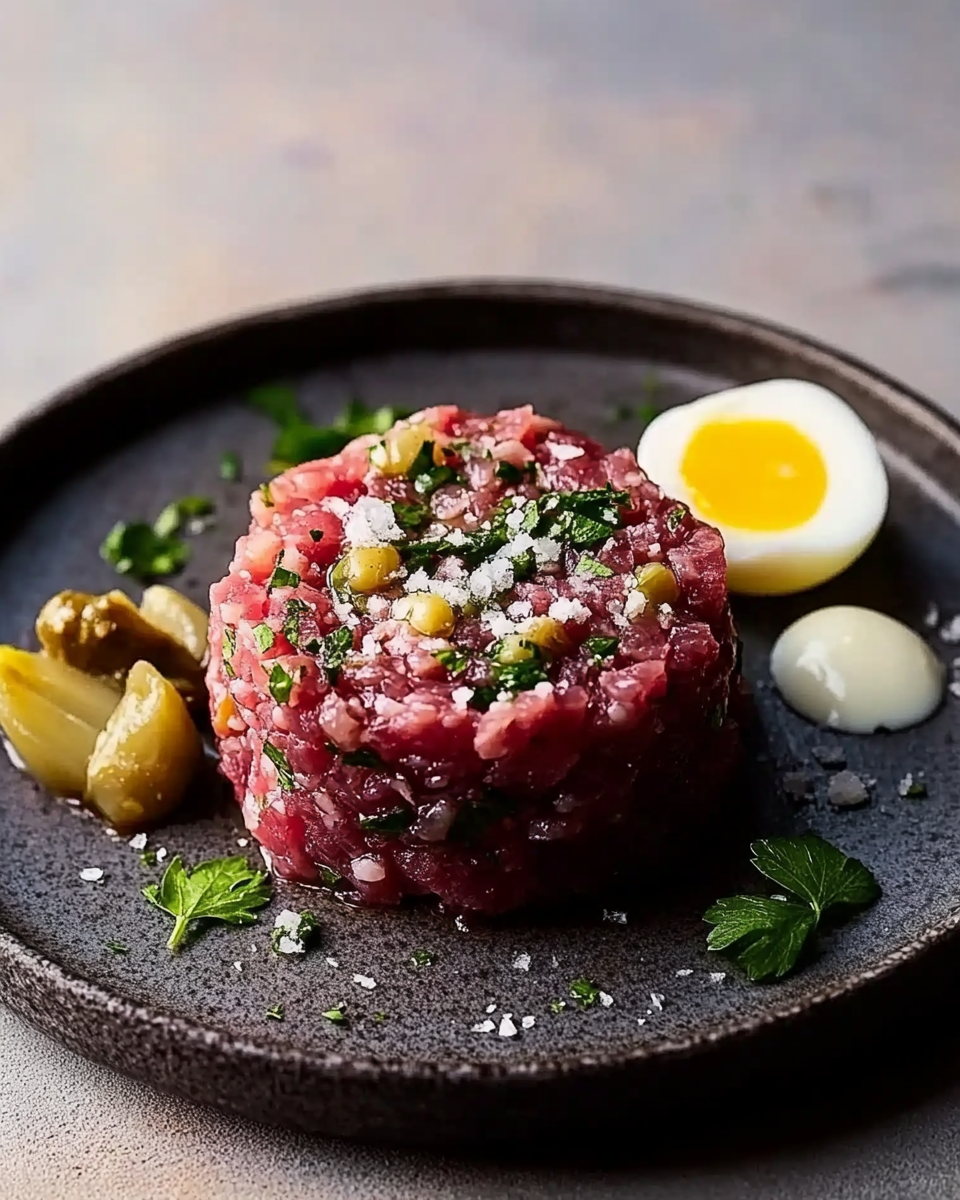The elegance of Steak Tartare lies in its simplicity and balance of bold flavors. This traditional French delicacy is made with premium raw beef finely chopped by hand and delicately seasoned with shallots, capers, mustard, and hot sauce. A fresh egg yolk crowns the dish, creating a luscious, creamy element that elevates each bite.
Whether served as a chic appetizer or a standout main dish, Steak Tartare pairs wonderfully with crusty baguette slices or crisp fries. It’s a dish that celebrates the beauty of pure ingredients and precise preparation—perfect for date nights, gourmet dinner parties, or simply when you’re craving something truly special.
Full Recipe:
-
250g quality beef fillet or sirloin, trimmed of sinew
-
1 small shallot, finely chopped
-
2 cornichons, finely chopped
-
1 tbsp capers, drained and chopped
-
1 tbsp flat-leaf parsley, finely chopped
-
1 tsp Dijon mustard
-
A few dashes of Tabasco or other hot sauce (to taste)
-
Sea salt and freshly ground black pepper
-
2 egg yolks (preferably organic, very fresh)
-
Toasted baguette slices or French fries, to serve
Directions:
-
Using a sharp, heavy knife, finely chop the trimmed beef until it reaches a tartare texture—neither too fine nor too coarse.
-
Transfer the beef to a mixing bowl. Stir in the chopped shallot, cornichons, capers, and parsley.
-
Add the Dijon mustard and a few dashes of hot sauce to taste. Season with salt and freshly ground black pepper.
-
Mix everything together gently to combine.
-
Spoon the mixture onto the centers of two chilled plates, shaping into a neat round.
-
Make a small indentation in the middle of each mound and gently place an egg yolk into each.
-
Serve immediately with toasted baguette slices or crispy French fries on the side.
Prep Time: 15 minutes | Cooking Time: 0 minutes | Total Time: 15 minutes
Kcal: 285 kcal (approx.) | Servings: 2 servings
The Origins and History of Steak Tartare
Steak Tartare is one of the most iconic dishes in French cuisine, celebrated for its boldness and purity. Although it’s commonly associated with French bistros and brasseries, its roots can be traced back centuries, with several theories about its origins. The most popular account ties it to the Tatars, a nomadic people of Central Asia, who were said to have softened their meat under saddles during long rides. While this theory is debated, it adds a touch of historical mystique to the dish’s legacy.
Modern Steak Tartare, as served in France, evolved from dishes like “steak à l’Américaine,” where raw minced beef was seasoned and often topped with a raw egg yolk. Over time, it became a refined delicacy in upscale Parisian restaurants, appreciated for its clean flavors and elegant presentation. The name “tartare” was likely borrowed from the tartar sauce that often accompanied the raw meat in its earlier renditions. Today, Steak Tartare is a culinary symbol of sophistication and minimalism, celebrated around the world.
Why Steak Tartare Stands Out
What sets Steak Tartare apart from other beef dishes is its reliance on raw, high-quality ingredients. Unlike grilled steaks or braised roasts, tartare doesn’t rely on heat or heavy sauces. Instead, it showcases the natural texture and flavor of raw beef, subtly enhanced by carefully selected condiments like capers, Dijon mustard, and shallots.
The dish’s raw nature is not only bold but also symbolic of a chef’s confidence in both technique and sourcing. Every element must be pristine—the beef fresh and well-trimmed, the yolk rich and clean, and the seasonings perfectly balanced. This makes Steak Tartare not just a meal, but a statement of culinary intention.
Regional and Cultural Variations
Though France is most closely associated with Steak Tartare, many cultures have their own version of raw minced meat dishes. In Ethiopia, kitfo is a beloved dish made with raw minced beef mixed with spices and clarified butter. In Lebanon and other parts of the Middle East, kibbeh nayyeh—a mixture of raw lamb or beef with bulgur and spices—is a festive specialty.
In Korea, a dish known as yukhoe features raw beef seasoned with sesame oil, soy sauce, and Asian pear. Each of these versions has its own texture, spice profile, and cultural significance, yet they all share a central appreciation for raw meat as a culinary art form. Steak Tartare fits comfortably within this global tradition, standing out with its European elegance and refinement.
The Role of Ingredients and Flavor Balance
A great Steak Tartare is all about balance. The richness of the raw beef is complemented by the sharpness of the shallots, the brininess of the capers and cornichons, and the tanginess of mustard. A dash of hot sauce adds a gentle kick, while chopped parsley brings a touch of freshness. Every component plays a role in heightening the flavor profile without overpowering the star ingredient—the beef.
Perhaps the most visually distinctive element is the egg yolk, typically nestled atop the seasoned meat. It brings a luxurious creaminess that binds the mixture when stirred together, creating a velvety mouthfeel that contrasts beautifully with the chew of the meat and the crunch of toasted bread or fries served alongside.
Serving Suggestions and Pairings
Traditionally, Steak Tartare is served with toasted slices of baguette or crispy French fries. The contrast in texture between the raw beef and the crunchy bread or fries makes for a delightful eating experience. In finer restaurants, it may be paired with microgreens, radishes, or pickled vegetables to add color and acidity.
For those enjoying a wine with the dish, a light red such as Pinot Noir or a dry rosé pairs beautifully, offering enough acidity to cleanse the palate without overshadowing the dish’s subtle flavors. For beer lovers, a Belgian saison or wheat beer makes a refreshing and slightly spicy counterpart.
It is also common in some restaurants to present the ingredients separately, allowing the diner to mix them to taste. This interactive presentation enhances the dining experience, giving control over flavor intensity and seasoning levels.
Modern Takes and Gourmet Interpretations
Contemporary chefs have taken the concept of Steak Tartare and expanded it with creativity and flair. You might find variations that use wagyu beef for an ultra-rich flavor or incorporate ingredients like truffle oil, pickled shallots, or even caviar. Some modern versions include aioli or infused oils to further enhance the dish’s complexity.
There are even tartare “towers” layered with avocado or beetroot, offering a colorful, Instagram-worthy presentation. Vegan takes on tartare are emerging as well, using finely diced beets, tomatoes, or mushrooms to mimic the appearance and texture of the traditional dish while offering a plant-based alternative.
Is It Safe to Eat Raw Beef?
One of the most common concerns regarding Steak Tartare is food safety. While it is absolutely safe when prepared properly, this dish does require attention to detail. The beef must be of the highest quality, freshly cut, and sourced from a reputable butcher. It’s typically recommended to use beef fillet or sirloin, as these cuts are lean, tender, and less likely to harbor bacteria when properly handled.
Egg yolks should be organic and very fresh, and anyone with a compromised immune system or pregnant women are generally advised to avoid raw preparations. However, for most healthy adults, Steak Tartare is not only safe but also highly nutritious—rich in protein, iron, and B vitamins.
Steak Tartare in Fine Dining Culture
In the world of fine dining, Steak Tartare is often used as a litmus test for a chef’s precision and respect for ingredients. It’s featured prominently in Michelin-starred restaurants and high-end brasseries, where its simplicity becomes a canvas for culinary artistry. Chefs might shape the tartare with rings for perfect presentation or use tweezers to position garnishes with precision.
Because it is served cold, every element must be meticulously prepared in advance, and the timing of service must be perfect. The visual appeal is as important as the taste—each plate must look like a masterpiece, underscoring the attention to detail that fine dining demands.
The Allure of Raw Cuisine
Raw dishes like Steak Tartare continue to appeal to adventurous eaters and those seeking a different kind of dining experience. There’s an immediacy and intimacy to eating something that hasn’t been altered by heat—it brings you closer to the ingredients, to the origins of the food itself.
Raw cuisine also emphasizes trust—trust in the chef, in the ingredients, and in the process. It is inherently more transparent, offering no place to hide. That vulnerability, combined with the boldness of flavor, is a big part of what makes Steak Tartare such a compelling and beloved dish.
Conclusion: A Dish of Precision, Purity, and Prestige
Steak Tartare remains one of the most elegant dishes in the culinary world. From its historical roots and international cousins to its modern interpretations, it continues to evolve while staying true to its essence: simplicity, boldness, and respect for the raw ingredient.
Whether you’re trying it for the first time or revisiting it as a longtime favorite, Steak Tartare offers a truly unique dining experience. It challenges conventional cooking norms while delivering exquisite flavor and texture. It’s not just a dish—it’s a celebration of craft, quality, and culinary courage.
For home cooks, it offers an opportunity to step outside the ordinary and into a realm of refined yet accessible cuisine. For professionals, it’s a badge of honor. And for food lovers everywhere, it’s an unforgettable bite of gastronomic tradition.






